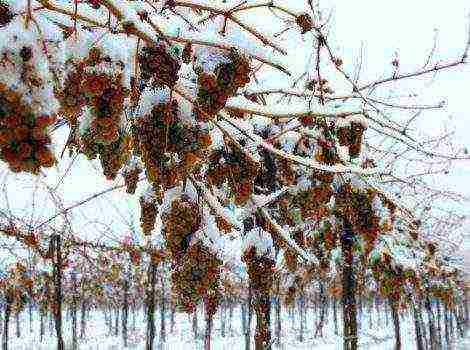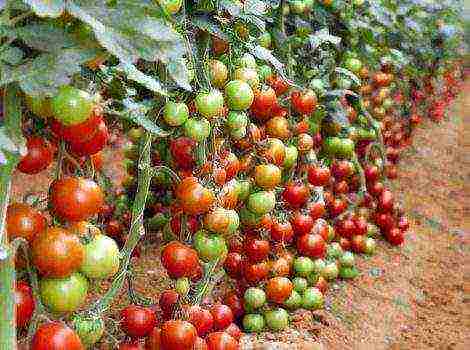Content
- 1 Amber
- 2 Yellow dessert
- 3 Yellow giant
- 4 Golden autumn
- 5 Golden domes
- 6 Orange miracle
- 7 Sweet yellow
- 8 Benefits of yellow raspberries
- 9 Features of yellow raspberries
- 10 Growing yellow raspberries
- 11 Yellow raspberry care
- 12 Reproduction of yellow raspberries
- 13 Promising varieties of yellow raspberries
- 14 Popular varieties of yellow raspberries
We offer a selection of proven varieties of yellow raspberries that will delight you with a generous harvest of tasty and healthy berries.
We are willing to bet that the word "raspberry" in your imagination comes up with quite an appetizing picture of a ruby-red berry, which you pluck from the bush and put it in your mouth with pleasure. What about yellow raspberries? The berries of these varieties are good not only for their unusual colors, but also for their excellent taste.
Yellow raspberries are sweeter than their red-fruited "sisters" and do not cause allergies. That is why it can be eaten without restrictions by pregnant women, lactating women, young children and allergy sufferers. A miracle, not a berry!
The only minus of yellow raspberries is their "delicacy". It is stored and transported worse than red-fruited. But this minor flaw does not prevent us from pampering ourselves with this delicious berry in season, does it?
Yellow raspberry is suitable for allergy sufferers, young children and nursing mothers
If you decide to plant yellow raspberries in your area, we advise you to opt for one of these 8 varieties. We guarantee you will not regret it!
Amber
The name of this variety is translated from English as "amber", and it fully justifies it. Amber berries are characterized by a beautiful amber hue, sweet aroma and excellent dessert taste.
Raspberries of this medium-late variety cannot boast of large fruits, but they are practically not susceptible to diseases and winters well, without requiring shelter.
| Fruiting | Bush height (m) | Fruit weight (g) | Pulp | Peculiarities |
| End of July - September | 2-2,5 | 3-4 | Sweet, dense | Disease resistant and pests |
Runaway
Raspberries of the Beglyanka variety cannot be called over-yielding (on average, about 2 kg of berries can be removed from a bush), but they are unlikely to give you a lot of trouble. She is not afraid of frost, pests and fungal diseases. But it is worth noting that plants of this variety are susceptible to infection with spider mites and mycoplasma overgrowth.
The fruits are distinguished by excellent taste with a slight sourness. And what a scent comes from the bush! This variety definitely deserves your attention.
| Fruiting | Bush height (m) | Fruit weight (g) | Pulp | Peculiarities |
| July-September | 1,5-2 | 3 | Sweet and sour | High winter hardiness |
Yellow dessert
This variety of yellow raspberries was bred in the Primorsky Territory more than half a century ago, but is still popular with gardeners. The bushes of the Yellow Dessert do not require the obligatory bending of the branches to the ground and shelter for the winter, but thanks to this procedure, their yield can be significantly increased. With proper care, more than 2 kg of juicy berries can be harvested from one bush.
| Fruiting | Bush height (m) | Fruit weight (g) | Pulp | Peculiarities |
| July-September | 1,5 | 2 | Sweet, juicy |
When berries are overripe |
Yellow giant
Raspberries of this variety are a giant in every sense. The height of the bush can reach 2.5 m, and the weight of one fruit is 6 g. This large-fruited raspberry is juicy, aromatic, sweet with a pleasant sourness.
It is worth noting the weak side of the Yellow Giant: the bushes of this variety are not distinguished by good winter hardiness. In autumn, the shoots must be bent to the ground and covered.
The yellow giant shows signs of renovation and can produce two crops per season.
|
|
||||
| Fruiting | Bush height (m) | Fruit weight (g) | Pulp | Peculiarities |
| July-September | 2-2,5 | 4-6 | Sweet and sour, juicy | Requires shelter for the winter |
Golden autumn
Raspberry remontant variety Golden Autumn is able to withstand frosts down to –30 ° C. In addition, it attracts gardeners with large tasty fruits, a fairly high yield (about 2.5 kg per bush) and good transportability.
It is worth considering that the seedlings of the Golden Autumn must be planted in a well-lit area, since the raspberry of this variety is photophilous and does not feel well in the shade.
|
|
||||
| Fruiting | Bush height (m) | Fruit weight (g) | Pulp | Peculiarities |
| From August - before frost |
2-2,5 | 5-7 | Thick, sweet | High frost resistance, good transportability of berries |
Golden domes
Raspberries of the Golden Dome variety are simple and unpretentious to care for. She winters well, practically does not get sick and brings a good berry harvest - more than 2 kg per bush.
The fruits of this variety are fragrant, juicy with a slight sourness.
| Fruiting | Bush height (m) | Fruit weight (g) | Pulp | Peculiarities |
| From August to frost | 1,3-1,5 | 6 | Sweet and sour, juicy | Resistant to diseases and pests |
Orange miracle
The Orange Miracle variety got its name from the large fruits of a rich golden color. They have a delicate aroma and sweet juicy pulp. The variety is remontant, therefore, every year (in late autumn or early spring), the entire above-ground part must be cut out almost at the very ground.
Raspberries of this variety are planted in well-lit, windproof areas. It is not necessary to cover the bushes for the winter.
|
|
||||
| Fruiting | Bush height (m) | Fruit weight (g) | Pulp | Peculiarities |
| From August to frost | 2-2,5 | 6-8 | Sweet, juicy | Doesn't like drafts |
Sweet yellow
The main advantages of Slastena yellow raspberries are excellent taste and high yield. In a good year, more than 3 kg of berries can be harvested from a bush. What is nice, the fruits do not fall off for a long time after ripening.
The variety is resistant to pests and diseases, but needs shelter for the winter.
|
|
||||
| Fruiting | Bush height (m) | Fruit weight (g) | Pulp | Peculiarities |
| End of July - September | 1,3-1,5 | 3-6 | Sweet, juicy | Overripe berries do not crumble |
***
Whichever of these varieties you plant on your site, we are sure that the mouth-watering and healthy berries of yellow raspberries will not leave you indifferent!
Yellow raspberry is one of the most interesting crops in our gardens. Yes, you do not meet it often, however, if you try to grow it, then it is already impossible to refuse, because it is not only a delicacy, but also beauty!
Benefits of yellow raspberries
The berries of yellow raspberries are less acidic, which is why they taste sweeter than red ones.
Beneficial features
A small amount of anthocyanins (dyes) allows them to be consumed in food by people prone to allergies, and by pregnant women and young children. The increased content of folic acid defines it as a means of strengthening the immune system, purifying the blood, maintaining new cells in a healthy state.
Yellow raspberry grade "Folgold" (Fall Gold)
Like the red rival, yellow raspberry, is a good expectorant and diaphoretic and antipyretic agent, has the ability to relieve spasms from tired vocal cords, helps with intestinal disorders, and helps to eliminate toxins from the body.
Usage
The berries of yellow raspberries are primarily eaten fresh, but in processing they are no worse than red berries. They make marmalade, marshmallow, jam, jams, compotes ...
Features of yellow raspberries
Most of the varieties of yellow raspberries belong to the remontant group. All modern varieties are distinguished by high yields, up to 6 - 9 kg per bush, have large berries, from 5 to 10, and even 12 g, extended fruiting, increased resistance to diseases and pests, to low temperatures.
There is an opinion that yellow raspberries are not only not transportable, but also do not keep their shape.This statement is actually true, but only in relation to old varieties, modern varieties have a dense drupe, excellent presentation and are well kept.
Yellow raspberry variety "Orange Miracle"
Growing yellow raspberries
The agricultural technology of yellow raspberries practically does not differ from the agricultural technology of growing red varieties.
Landing place
Saplings are planted in open sunny areas, in places where there is no stagnation of moisture and there is protection from cold northern winds. It is better if the rows are located from north to south or from north-east to south-west, because this way the plants have the opportunity to get maximum light, which is especially true for areas with short cold summers.
If there is a choice, then the most acceptable option for breaking a berry plant is a flat area or a slope up to 8 ° C. A place after nightshade is not permissible, due to the defeat of this group of crops by verticillary wilt. Raspberries are not planted after the raspberries, leaving the land for rest for 5 years.
Soil for yellow raspberries
The best results can be achieved by planting yellow raspberries on sandy and light loamy soils. On sandy soils, plantings will need more painstaking care. But on heavy acidic soils, it is better not to break the raspberry tree at all (if the pH of the soil is <5.5, it is not suitable for planting raspberries).
Landing dates
Like red raspberries, yellow varieties are planted in the fall - at the end of September to mid-October (in the southern regions, a few weeks later or in early spring).
The most effective planting method is trenching with a row spacing of 1.2 - 1.6 m (and for tall varieties and 2 m), a trench width of 0.5 - 0.6 m. be 0.4 m or more.
Saplings are not buried when planting.
Yellow raspberry care
Fertilizers
In order for the yellow raspberry to give a good harvest (stated in the description for the variety), competent care is necessary for it. And the first thing to start with is feeding.
If the culture is planted by the trench method, you can forget about fertilizing for several years. In other cases, it needs nitrogen, phosphorus, potassium, boron, iron, manganese.
Many articles have been written about how to properly feed raspberries and many recommendations have been given, however, the common opinion of scientists is the following: the yield of this crop largely depends on the growth strength of the bush at the initial stage of life. Therefore, the raspberry tree for the first three years should be supplied with nitrogen in abundance. For this, nitrogen fertilizers are applied under it already in February-March, localizing them closer to the bushes for the first two years, and then scattering them in a row.
Sometimes the dose is divided into two parts, for the first time feeding the raspberry tree in the fall. At the same time, in the autumn-winter period, part of the nitrogen is washed out, but on the other hand, spring feeding stimulates raspberries to form a large number of shoots, which is also not very good.
Yellow raspberry variety "Morning dew" (Porana Rosa, Porana Rosa)
You can also choose the following scheme: in the first year of plant life, divide the fertilizing with nitrogen and into three parts - the first one should be carried out in early May, the second and third after two weeks, with an interval of two weeks. In subsequent years, leave only the spring fertilization.
The best nitrogen fertilizer in this case is urea, but not in dry form, but diluted in water (50 g per 10 l). Under a bush, such a solution is enough in a volume of 1 liter.
Evidence of the full development of raspberry bushes (not excessive and not inhibited) will be an increase of 10 - 12 strong replacement shoots, up to 1.5 - 2 m high (depending on the variety), with the length of internodes (in the middle part of the shoot) about 8 - 10 cm ...
The rest of the elements are introduced as needed, which can be determined either by a laboratory method, or by focusing on external signs: the color and general condition of the leaves, the length of internodes, the intensity of shoots.
If you do not use fertilizers on your site, apply cow or horse manure under raspberries in the fall, every 2 - 3 years, in the amount of 2.5 - 3 kg per square meter, and also arrange feeding with ash.
Watering yellow raspberries
Another factor that has a direct impact on the amount of the crop is watering. In the south, raspberries are watered 6 to 8 times during the growing season: during the period of intensive shoot growth, before flowering, in the phase of green ovary formation and after harvesting. In the conditions of the middle lane, 2 - 4 waterings are enough: during the period of intensive growth of shoots and after harvesting.
You can water the raspberry tree either along the furrows or by sprinkling.
Yellow raspberry garter
If the selected variety requires a garter, then by the second year after planting, pillars must be installed in the rows of raspberries and a trellis should be pulled over them. The first row of wires is pulled at a height of 1.2 - 1.5 m from the soil surface (depending on the height of the plants), the two lower ones on both sides of the row at a height of 0.6 - 0.7 m. The garter is done before the buds open.
Pruning yellow raspberries
Yellow raspberries also need proper pruning. Repaired varieties are pruned either immediately after fruiting, removing only the fruit bearing shoots, or in the autumn or early spring, completely cutting off the bush. In the first version, this makes it possible to strengthen new shoots and give a full autumn harvest. In the second, it forces the plants to skip the first, but give a more significant second harvest.
Pruning varieties are pruned in one or two stages in order to increase first and second order branching.
In addition, it is important to remember that yellow remontant varieties do not like thickening, reacting to it with a decrease in the quantity and quality of the crop. Therefore, in the spring on the raspberry tree, it is necessary to carry out thinning, leaving 4 to 7 well-formed shoots on the bush.
Weed control
An important point in the cultivation of raspberries is also weed control and loosening of the soil.
Shelter of yellow raspberries for the winter
In most cases, yellow raspberry varieties have sufficient resistance to low temperatures, however, where the winter is cold for them, it is better to take care that severe frosts do not destroy the raspberry tree. To do this, at the end of September - October, raspberry branches are tilted along the row and tied in such a way that they are not higher than 0.4 m above the ground.In places where especially low temperatures are observed in the absence of snow, raspberries are additionally covered with straw. or ground.
Reproduction of yellow raspberries
Most often, yellow raspberries are propagated by seedlings. However, if you wish, or if you cannot get planting material, you can try to get plants from seeds. This is not a simple matter - raspberry seed material requires special storage conditions, proper preparation for sowing and has poor germination, but if you tinker with it, you can get a fairly good result, with a satisfactory, or even high, yield potential.
In order to propagate yellow raspberries with seeds, it is necessary to wash the ripe berries from the pulp, dry the resulting seeds and put them in a paper bag for storage. By the end of September, place the seed in a bag (it can be made from a nylon stocking) and soak it in water for a day. Then, right in the bag, wrap in a dive, planting young plants with an interval of 5 cm sphagnum moss (with a layer of 3 - 5 cm) and place in a cool place with a temperature of 2 - 3 ° C. If it is difficult to find moss, place it in a container with wet sand. In the first ten days of April, sow the seeds on the garden bed in rows with row spacing of 40 cm. After the seedlings have risen.
In summer, the seedlings are routinely treated: watered, loosened, weeds are removed. In the fall, young raspberries are transplanted to a permanent place. At the same time, plants with dark thorns are discarded - raspberries with yellow berries will not grow out of them.
Yellow raspberry variety "Yellow Giant"
Promising varieties of yellow raspberries
Yellow giant... The variety is semi-renovated. Medium early. Has repeated autumn fruiting. One of the sweetest table varieties. The berries are amber-yellow, very large, weighing about 9 g, dense, fragrant, practically do not crumble, suitable for transportation. Productivity, with proper care, ranges from 4 to 8 kg per bush. The bush is tall, powerful, spreading, well forms lateral shoots, reaches a height of 2.5 m (shoots are thornless). Requires a garter to the trellis. Possesses high resistance to pests and diseases. Winter-hardy enough.
Morning dew (Polish name - Porana Rosa). Industrial grade. One of the most aromatic. The berries are round, amber in color, dense, weighing from 5 to 10 g, sweet and sour taste. Productivity up to 3 kg per bush. It has a medium-sized bush, up to 1.8 m high, erect, powerful shoots. Not picky about growing conditions, but in the heat it loses its sugar content. Possesses low resistance to fungal diseases. The fruiting period is the first half of June, the second decade of August - before frost. The greatest yield is obtained with one-time fruiting.
Sweet yellow... The variety is medium early, not remontant. Differs in high resistance to diseases and pests, average winter hardiness. Berries are yellow and white-yellow, oblong, medium and large, weighing from 3 to 6 g, aromatic, dessert taste, do not crumble, but are not suitable for transportation. Productivity, with proper care, is from 3 to 8 kg per bush. The bush is medium-sized, up to 1.5 m high, spreading. Shoot-forming ability is moderate. Shoots are thornless.
Yaroslavna, Brusvyana yellow, or Rosyanitsa... The variety is mid-season. Remontant. More suitable for the south. It has two fruiting periods - from the second decade of June, and from the second decade of August until frost. Berries are bright yellow, large, sweet and sour, weighing 10 - 12 g. Transportability is average. Productivity 4 kg per bush. The bush is of the standard type, medium-sized, up to 1.7 m high. Does not need a garter. Weakly branching shoots. There are few thorns.
Yellow raspberry variety "Folgold" (Fall Gold)
Fall gold (Folgold), "Golden Autumn", sometimes translated as "Golden Rain". The grade is remontant. Possesses increased resistance to pests and diseases. Berries are golden-yellow, conical, fragrant, very sweet, dessert taste, weighing from 4 to 7 g. Yields up to 7 kg per bush. Fruiting is extended. The bush is powerful, spreading, up to 2.5 m high.
Orange miracle... The variety is remontant, but it is recommended for one-time fruiting. Very unpretentious, sun-loving, winter-hardy. Possesses high resistance to diseases and pests. The berries are bright orange, elongated-conical, dense, weighing from 4.5 to 6 g, do not crumble, have high transportability. Autumn harvest from 2 to 2.5 kg per bush. The bush is up to 1.5 m high, semi-spreading, requires a garter.
Fool gold (Fulgodl), or The Golden Fool. A remontant variety, but recommended for a one-time harvest. Resistant to heat and low temperatures. Berries are light amber, very sweet, aromatic, weighing from 4 to 9 g. Transportable. The bush is high, up to 1.6 m.
Yellow raspberry, a berry shrub with yellow fruits is not grown commercially. Can be found only in private gardens, in summer cottages. I can explain this by the fact that the seedlings of the best varieties of yellow raspberries are not so easy to buy in nurseries, although there is great interest in them. I think that, firstly, this is due to the attractive unusual color of the berries. And, secondly, it has a pleasant taste, sweeter than that of red-fruited or black-fruited varieties.
 In addition, the composition of the fruit contains a small percentage of anthocyanins, that is, yellow raspberries, its fruits can be attributed to dietary products. Allergy sufferers and children can safely eat it in any (reasonable) amount, without fear of an allergic reaction.
In addition, the composition of the fruit contains a small percentage of anthocyanins, that is, yellow raspberries, its fruits can be attributed to dietary products. Allergy sufferers and children can safely eat it in any (reasonable) amount, without fear of an allergic reaction.
There are, of course, disadvantages. The berries of yellow raspberries are less dense, so they are practically not transportable, in contrast to the red ones.Although the selection of varieties does not stand still - there are already varieties, the berries of which can withstand transportation. These are, for example, Amber, Golden Autumn, and others.
Yellow-fruited raspberry, like any other, is a perennial berry bush. She also has one-, two-year-old stems with a perennial root system. Like common raspberries, they have a two-year development cycle. That is, in the first year, new shoots appear, on which fruits appear in the second year. Then they die off - they are also cut out, removed.
Yellow raspberries are common and remontant. Like any, red or black, the common one ripens in June (Kuban), July (the middle zone of Russia), and the remontant blooms, bears fruit twice a year. The second time is in August-September.
Planting and caring for yellow raspberries is the same as for red ones. By the way, ordinary yellow-fruited raspberry varieties are frost-resistant, therefore they do not require additional shelter for the winter. Caring for remontant varieties is different, we'll talk about this below.
↑ to the content ↑ Repaired yellow raspberries - planting and care
Bushes of remontant yellow raspberries can be planted in rows, in strips - this is the so-called strip planting method. 1.5-2 meters are left between the rows, and in a row, the distance between the seedlings when planting is 50-60 cm.
If you plant seedlings in early spring, then in the fall, with proper care, you can already get the first berries.
The difference in caring for remontant varieties of yellow raspberries is that in the fall, after harvesting, all fruiting shoots are cut out. Pruning is done very low, at the very surface of the ground.
Spring care also has its own characteristics. As soon as the shoots reach 10-15 cm in length, weak shoots should be cut. 10-20 stems should remain on an area about 1 meter long.
By the way, remontant varieties of yellow raspberries can be grown without treating them from diseases and pests. Indeed, in the fall, all shoots are removed, which means that the timely removal of diseased or pest-infected shoots, sources of infection, occurs.
Repaired yellow raspberries bloom late. This saves the plants from the raspberry beetle larvae, which appear on common raspberry varieties a month earlier.
Another feature is that in winter the area with remontant yellow raspberries looks empty, the roots with buds of future shoots are in the ground, therefore, with a snowless frosty winter, you should cover the rows with sawdust or fallen leaves. In the Kuban, remontant raspberries do not need to be covered.
↑ to content ↑ Varieties of yellow raspberries Beglyanka
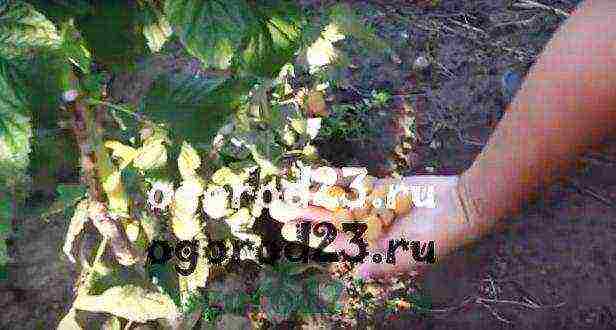
- Ripening period is early (in the Kuban it is the beginning of June).
- The size of the berries is small (up to 3 g), the color is golden with a slight apricot tint, the taste is excellent.
- The disadvantage is that the variety is not transportable.
Runaway shoots reach a length of 1.7-2 m, erect, almost no thorns. Up to 2 kg of berries can be harvested from one bush. The variety has high frost resistance, medium drought resistance, heat resistance. The fugitive is resistant to major fungal diseases, but not resistant to spider mites.
↑ back to contents ↑ Sweet yellow
- Ripening period - mid-early.
- The size of the berries is large and medium (3-6 g).
- Color - pale yellow.
- The shape of the berries is conical.
- Feature - berries do not crumble for a long time, soft, very fragrant.
The yield is higher than that of the Runaway - 3-4 kg from one bush. Shoots of Sweet yellow - up to 1.5 meters, no thorns. Sprawling bushes. To facilitate maintenance, harvesting, it is better to tie them up in the spring or limit excessive spreading with a wire fence on both sides. In spring, the plant forms from 6 to 8 shoots of replacement and several (2-4) shoots of overgrowth. From 15 to 20 berries are tied and ripen on fruit twigs. Sweet yellow is resistant to diseases and pests. Disadvantages - the berries are not transportable, the stems must be bent to the ground for the winter and shelter from frost in the middle lane.
↑ to content ↑ Amber raspberry variety
- Ripening period is medium late.
- The size of the berries is medium (3-4 g).
- The color is beautiful, orange-yellow, amber.
- The shape of the berries is round-conical.
- The berries are dense, do not crumble for a long time, fragrant.
- The taste is sweet.
Amber's shoots are tall, powerful, with thorns, erect, from 2 to 2.5 m high, do not crumble, stand pressed against each other. It tolerates winter frosts well without bending the shoots to the ground. It forms many shoots of replacement - from 8 to 12, shoots of shoots - 4-5. On fruit branches - from 10 to 16 berries. From one bush, you can collect up to 3 kg of berries per season.
↑ to content ↑ Yaroslavna raspberry variety
 Raspberry yellow-fruited remontant. The variety has another name - Yellow Brusvyana. Bred, zoned for Ukraine, so it will grow best in the south. There are two ripening periods - the first in early June, the second - from August to the very frost.
Raspberry yellow-fruited remontant. The variety has another name - Yellow Brusvyana. Bred, zoned for Ukraine, so it will grow best in the south. There are two ripening periods - the first in early June, the second - from August to the very frost.
- The size of the berries is large, of medium hardness.
- The taste is pleasant, sweet and sour.
- Transportability is average.
- The color is bright yellow, the berries on the bush look very appetizing.
- The yield is high.
Shoots of Yaroslavna are straight, up to 1.7 m high, branching weakly. Standard type bush. Up to 4 kg of berries can be harvested from one bush.
↑ back to contents ↑ Golden Autumn
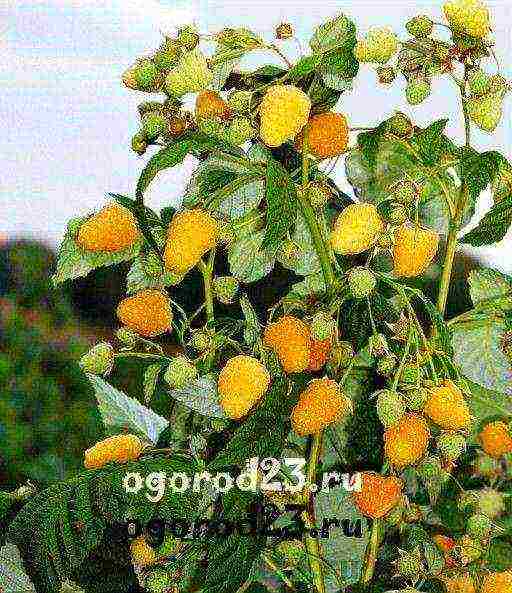 Raspberry yellow-fruited remontant.
Raspberry yellow-fruited remontant.
- Ripening period is medium late.
- The size of the berries is large (about 5 g), dense, transportable.
- The shape is elongated-conical.
- Color - golden yellow with slight pubescence.
- Taste - sweet berries with a strong raspberry aroma.
Fruiting on the shoots of the current year, in the fall. After harvesting, all shoots are cut to the ground. Winter hardiness is very high. Be sure to plant this type of raspberry in a sunny place, as it does not tolerate even light shading - the yield drops. Shoots of medium height, not higher than 1.6 m, thorns are only at the bottom. Despite not very tall, the bushes require a garter.
↑ back to content ↑ Apricot
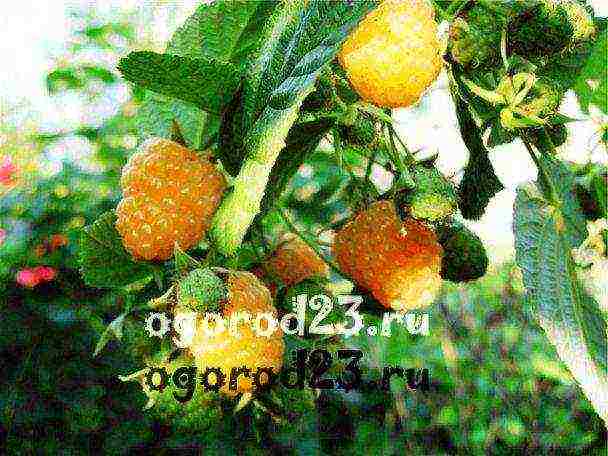 Raspberry yellow-fruited remontant. This is one of the most fruitful (1.5-2 kg per bush) varieties of yellow-fruited raspberries with the most unusual sweet taste - you will feel the light taste of apricot even after eating a few berries. But the apricot flavor may not be there, apparently, it depends to some extent on the weather - it rains or not. Even the color of the berries is not like other yellow-fruited varieties - yellow with a pinkish tinge. The shape of the berries is a blunt cone. Shoots are erect, strongly branching, 1.3-1.6 m long. The bushes are not spreading, but they require a mandatory garter, since untied bushes can fall from the abundance of berries. There are thorns, but they do not interfere with harvesting, as they are located at the bottom.
Raspberry yellow-fruited remontant. This is one of the most fruitful (1.5-2 kg per bush) varieties of yellow-fruited raspberries with the most unusual sweet taste - you will feel the light taste of apricot even after eating a few berries. But the apricot flavor may not be there, apparently, it depends to some extent on the weather - it rains or not. Even the color of the berries is not like other yellow-fruited varieties - yellow with a pinkish tinge. The shape of the berries is a blunt cone. Shoots are erect, strongly branching, 1.3-1.6 m long. The bushes are not spreading, but they require a mandatory garter, since untied bushes can fall from the abundance of berries. There are thorns, but they do not interfere with harvesting, as they are located at the bottom.
↑ Back to Contents ↑ The Yellow Giant
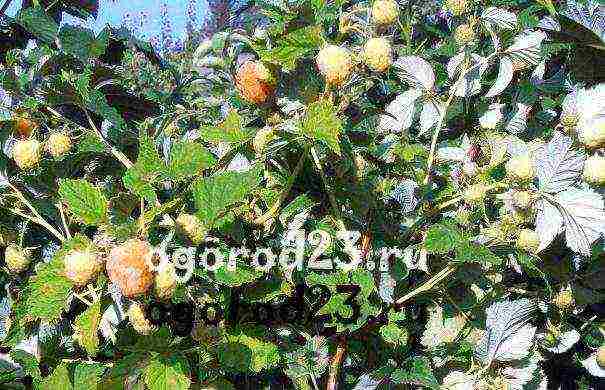 Semi-renovated yellow-fruited raspberry. According to reviews, it is the best variety of all yellow-fruited.
Semi-renovated yellow-fruited raspberry. According to reviews, it is the best variety of all yellow-fruited.
- Firstly, the fruits are very large, juicy, very, very sweet.
- Secondly, it is very yielding - from 3 to 6 kg per bush.
- Thirdly, good resistance to major diseases and pests. Fourthly, it bears fruit until the very cold.
- There are two more advantages - the variety is good, it multiplies easily, as it gives a lot of growth, belongs to winter hardy.
But this variety also has disadvantages - the berries are not transportable, therefore it is not suitable for growing on an industrial scale, but in private gardens or in summer cottages it will certainly delight you with a delicious harvest. In addition, if you are slightly late with the harvest, the berries will crumble. And yet there are small thorns along the entire length of the stem.
The size of the berries is large and very large (up to 8 g). According to some reviews, it reaches the size of an average walnut. The shape of the berries is a blunt or rounded cone. The stems are powerful, thick, up to 2.5 m high, and requires a mandatory garter. Fruit twigs grow up to 40 cm long, at least 20 berries are formed on them. Since the variety is semi-remontant, you should not cut off the shoots to the ground in the fall.
In addition to the usual crimson and red for us, there is varieties of white and yellow raspberries... The cultivation technology of these varieties is not much different from each other, but if you decide to grow yellow raspberries on your site, you need to take very seriously the choice of the species, since most of them, when harvesting, are scattered into drupes right in the hands of the picker. Such raspberries are unattractive to the market, and you can't put them on the table in front of the guests.
It is worth paying attention to some varieties, the fruits of which, after harvest, within 1-2 days, retain their shape and are suitable for transportation.Such raspberries have an attractive presentation and are in high demand.
It is noticed that if the raspberry fruit consists of a small number of large drupes, then during harvesting it usually crumbles into its component parts, and the fruit with a large number of small drupes rarely crumbles, since these drupes are tightly connected to each other. This means that when choosing a variety, you need to look at whether the drupes are tightly connected to each other, the stronger, the longer the berry has an attractive presentation.
And one more important circumstance: you do not need to plant only one variety, although raspberries are a single-fruited plant, they give a higher yield when cross-pollinated, the berries are richer and fuller. Hence the conclusion - to plant 2 - 3 varieties of raspberries on one plantation. It is desirable that these varieties are resistant to frost, pests, diseases and have a high yield and tasty, large berries.
Popular varieties of yellow raspberries
Apricot
 Apricot - a medium-ripening variety, golden-colored berries, blunt-conical, with small intertwined drupes, good taste. The bush, depending on the growing conditions, is vigorous or medium-sized.
Apricot - a medium-ripening variety, golden-colored berries, blunt-conical, with small intertwined drupes, good taste. The bush, depending on the growing conditions, is vigorous or medium-sized.
Shoots grow up to two meters in height, they need a garter, in the lower part of the shoot there are large, strong thorns. The leaves are green and large. Replacement shoots, root forms few. The first crop is harvested in June, the second - from mid-August until frost.
Victoria Cornwall
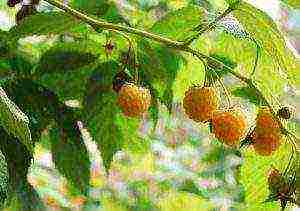 The variety came to us from Western Europe and did not take root very well, it is mainly grown by amateur gardeners. The berries are large, oval, light yellow in color. The drupes are tightly bound.
The variety came to us from Western Europe and did not take root very well, it is mainly grown by amateur gardeners. The berries are large, oval, light yellow in color. The drupes are tightly bound.
The fruits have excellent taste, when stored carefully for up to 2 days, they retain their presentation, but the variety did not take root due to poor frost resistance. It can be grown in the southern coastal regions and in the Crimea. This is one of the best dessert raspberries.
Bushes of medium height, spreading, erect shoots, dark green leaves, corrugated. Young shoots are light green, there are many thorns, located throughout the shoot.
Golden domes
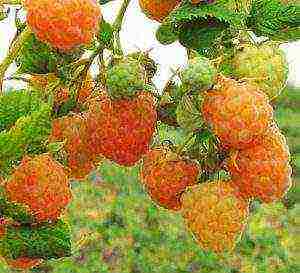 Golden domes are a common remontant variety. The bush is low, up to one and a half meters, spreading. The berries are large, bright yellow, attractive. The first crop is harvested in late June - early July, the second - from August to frost.
Golden domes are a common remontant variety. The bush is low, up to one and a half meters, spreading. The berries are large, bright yellow, attractive. The first crop is harvested in late June - early July, the second - from August to frost.
It is noteworthy that the variety is resistant to various types of diseases and pests, which allows you to get large yields even without serious care throughout the year.
Morning dew
A variety from Poland, with very large berries. Drupes are small, tightly linked together. The yellow, hemispherical berry has a very attractive appearance, weighs 5-8g and does not lose its shape for a long time.
The bush is quite high, up to about two meters in height, the shoots need to be tied up, since under the weight of the fruits they bend almost to the ground.
Spirina white
This is a Russian variety, bred in the city of Nikolsk, V.V. Spirin. The fruits are oval, with a large number of drupes, interconnected. The berries are juicy, sweet and sour, tasty, high transportability. This is one of the best varieties of white raspberry, as it is distinguished by high yield and frost resistance, as well as the quality of the fruit.
If you find an error, please select a piece of text and press Ctrl + Enter.

